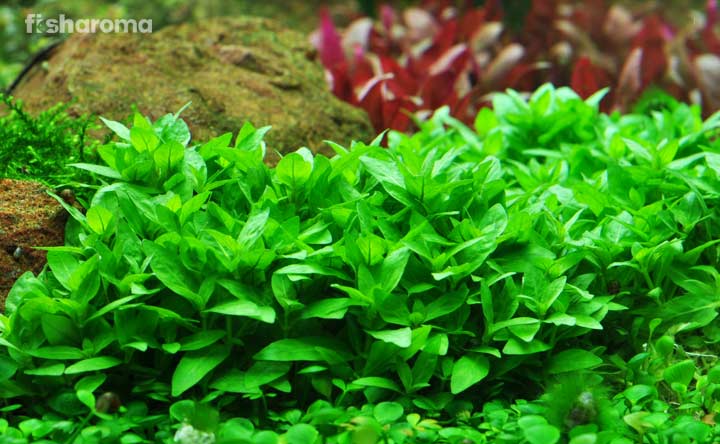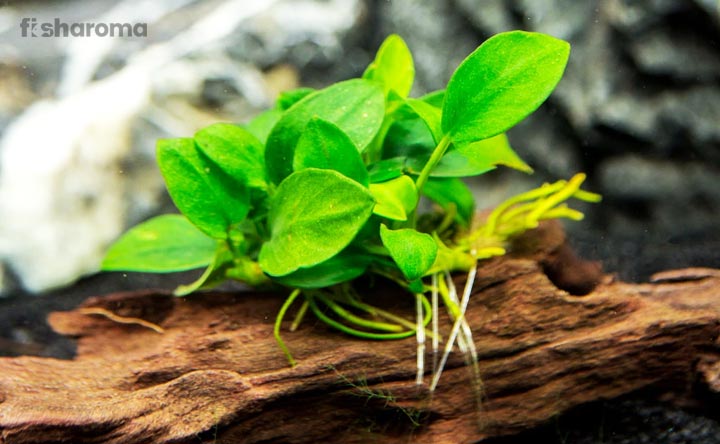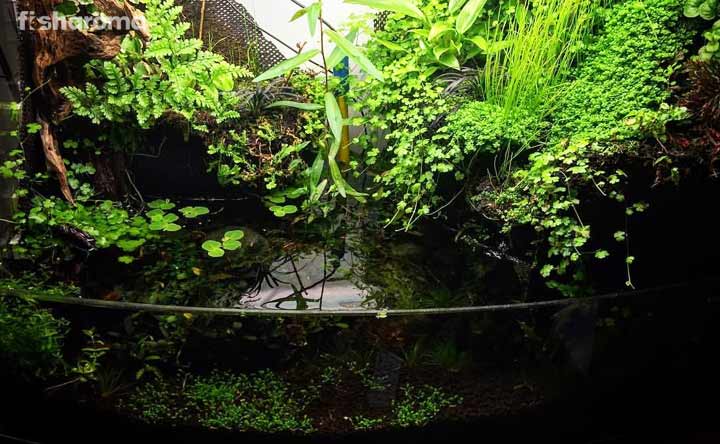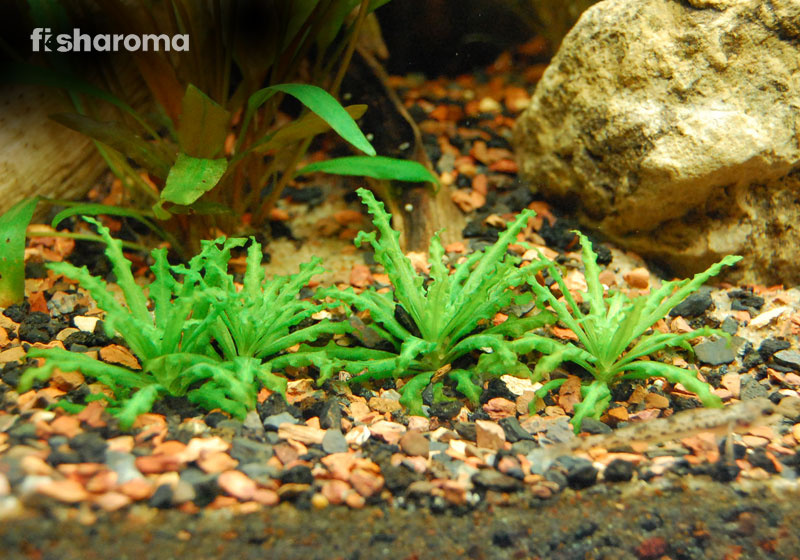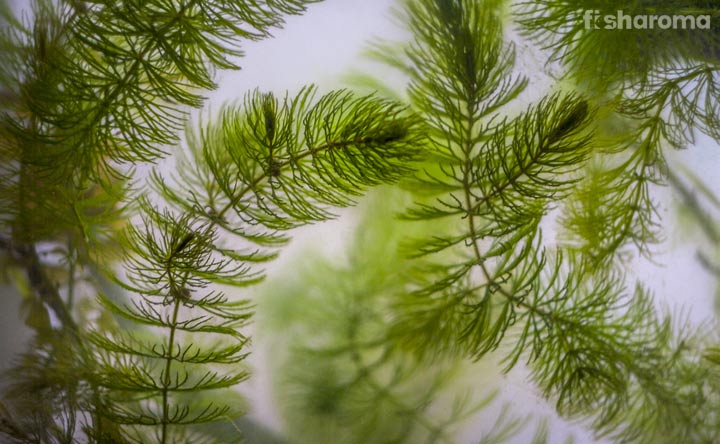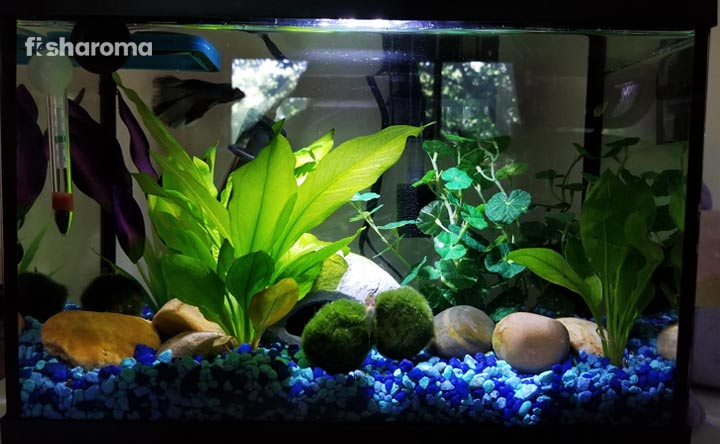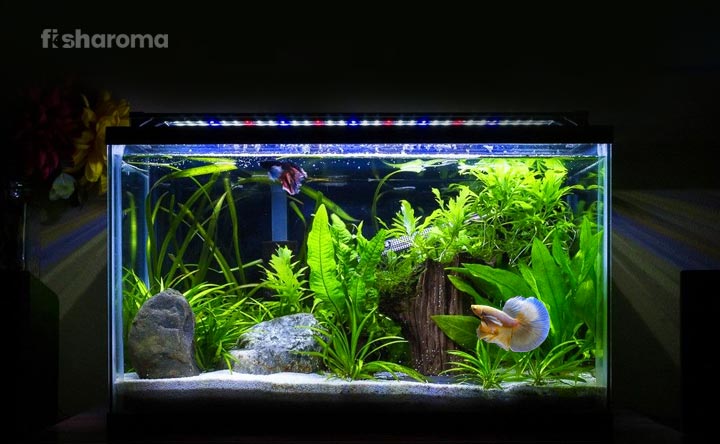15 Best Aquarium Plants to Create Natural Ambiance for Your Pet Fish
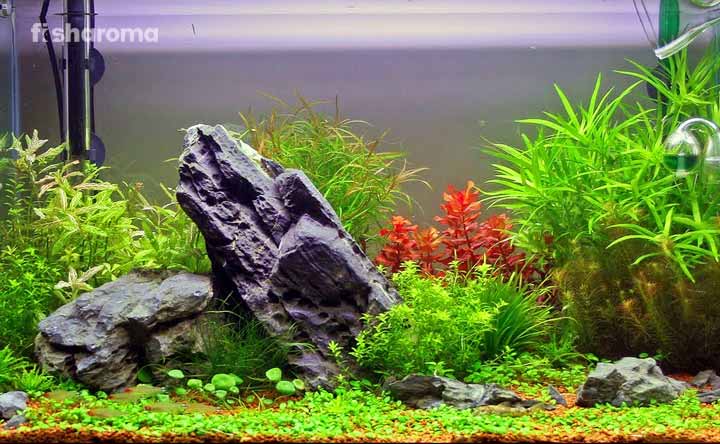
- Best Aquarium Plants
- 1. Amazon Sword
- 2. Anubias
- 3. Java Moss
- 4. Java Fern
- 5. Hornwort
- 6. Pygmy Chain Sword
- 7. Water Wisteria
- 8. Vallisneria
- 9. Cryptocoryne
- 10. Dwarf Water Lily
- 11. Dwarf Baby Tears
- 12. Duckweed
- 13. Ludwigia Repens
- 14. Dwarf Hairgrass
- 15. Anacharis
- Benefits of Keeping Aquarium Plants
- Summary
Buying an aquarium is never a big deal, but providing a healthy ambiance to the fish inside the aquarium is! To provide a nature-like home in the aquarium, there’s no better way than to introduce aquarium plants in your freshwater tank. If the maintenance of the aquarium plants makes you worried, this article can help you with all that you need to know!
However, several aquarists prefer to skip the aquarium plants because they believe it makes the aquarium unnecessarily congested. Also, some people think that the fish may uproot the plants and make a mess inside the aquarium.
Well, both these claims are not completely baseless, but if you select the aquarium plant according to your tank inhabitants and tank size, your aquarium can have a better appearance and appeal, and its health quotient can be maximized.
Now, if your next confusion is the “which aquarium plant will be alright for your aquarium?” let us assist you there too!
Best Aquatic Plants for Your Aquarium
There are so many options for aquatic plants to select from. For example, there are multiple floating plants to provide shelter to the fish. Similarly, there are low-light aquarium plants if your fish is intolerant of excess light.
If you are a beginner, several aquarium plants are there that are easy to care and maintain, thus taking off the load from your shoulders. Are you looking for a magnificent green carpet in the aquarium base? Or are you want a colorful plant so that it contrasts with your fish? Don’t worry; you can get both in terms of aquarium plants.
So just take a look at these 15 best aquatic plants and make your aquarium more beautiful.
1. Amazon Sword

| Scientific Name | Echinodorus grisebachii |
| Temperature | 60-82° F (15-27.7° C) |
| pH | 6.5-7.5 |
| Lighting | Mild |
| Growth Rate | Medium |
It is a beginner-friendly aquatic plant that comes with easy care. Amazon Sword is recommended for almost all the freshwater fish because of its wide range of accepted temperature. This plant has long leaves, and when it is put in the aquarium, it looks like the bushes.
Another reason for being the most popular aquarium plant is this plant requires hardly any arrangements – it gathers all the essential nutrients from water and substrates. So, go ahead and just insert its root in the substrate and see it grow without any such care.
You can cut a stem of this plant and place it anywhere to see that growing without any abnormalities.
The omnivorous fish like Guppy, Molly, Danio, and Platy find themselves very safe to be with this plant. But the aggressive and larger species may uproot this plant. So, take care of it.
2. Anubias

| Scientific Name | Anubias barteri var. nana |
| Temperature | 72-82° F (22.2-27.7° C) |
| pH | 6.0-7.5 |
| Lighting | Low |
| Growth Rate | Slow |
Anubias is an ideal aquarium plant for those who want a nature-like an ambiance for the fish in a thin layer of substrates. Also, if you need a slow-growing plant with a low light requirement that mainly works as a décor, Anubias can help.
Planting of this plant is very easy as you can simply place it in the substrates or in the driftwood. A broken part of the plant starts growing right after it falls in the substrates, and it is probably the best part of this plant.
Keeping Zebra Danio, Dwarf Gourami, Cherry Barbs, and Mollies are alright because they hardly have any intention to eat or uproot Anubias. As large species often uproot this plant, skipping them is a wise idea.
3. Java Moss

| Scientific Name | Vesicularia dubyana/Taxiphyllum barbieri |
| Temperature | 59-86° F (15-30° C) |
| pH | 5.5-8.0 |
| Lighting | Low |
| Growth Rate | Slow to medium |
Want a stunning green carpet in your aquarium? Java Moss alone is enough to help here. It can be added to any tanks irrespective of the temperament of the species. Just like any other aquarium plants, you don’t need to take any care of this apart from trimming the plant after a specific duration.
You have to tie down Java Moss to a piece of rock so that it can rise to the surface area. Place it anywhere and see it forming a carpet slowly, which is the favorite resting place for the bottom dwellers.
As it is like a carpet, it is alright to keep Java Moss in any aquarium. Aggressive or peaceful species generally don’t seem to mess with the aquarium substrates, so do add this in your aquarium.
4. Java Fern

| Scientific Name | Microsorum pteropus |
| Temperature | 68-82° F (20-27° C) |
| pH | 6.0-7.5 |
| Lighting | Low to Moderate |
| Growth Rate | Medium |
Java Fern is a low-light aquatic plant that can survive in a wide range of temperature and pH in your freshwater aquarium. All you need to place this plant under the substrates. Alternatively, you can also attach it to the logs or driftwood. That’s all!
Yes, you don’t need to take any such care for Java fern further. Along with rhizome division, this plant produces small ferns under the leaves, which can be cut after their growth to plant somewhere else.
If your tank has several large species like Cichlid or Oscar or Arowana, Java Fern is the best plant for you because they do not like to spend hours at the bottom.
5. Hornwort

| Scientific Name | Ceratophyllum demersum |
| Temperature | 59-86° F (15-30° C) |
| pH | 6.0-7.5 |
| Lighting | Moderate |
| Growth Rate | Fast |
Hornwort is typically a floating aquatic plant, but it can be planted in the substrates too. This plant can prevent avid jumpers from jumping outside of the tank.
Apart from that, floating plants are considered the safe shelters under which a fish can rest. Also, it helps to avoid over-lighting conditions. Another advantage of placing Hornwort in the aquarium is it can effectively prevent algae growth by preventing light from coming in.
Asexual reproduction can be seen in this plant, and it can be put in various community tanks. Hornwort leaves are appeared to be the safe shelters for the newly-hatched fries as well as the eggs. Keeping Hornwort with aquarium plants is harmful to some extent as the chemical, released from this plant gradually weakens and kills other plants.
6. Pygmy Chain Sword

| Scientific Name | Echinodorus tenellus |
| Temperature | 68-84° F(20-28.8° C) |
| pH | 6.2-7.5 |
| Lighting | High |
| Growth Rate | Fast |
Pygmy Chain Sword at once enhances the beauty of your aquarium as its leaves are slightly red towards the edges. Unlike other plants, you cannot place it anywhere other than sandy substrate or gravel substrate is mandatory for this plant.
This aquarium plant produces own runners, which is a reason for the fast formation of the carpet. If you want the carpet even faster, you can cut those runners and plant those somewhere else.
A thick carpet of this plant looks amazing in the aquarium, but a problem with this plant is it needs 10-12 hours of light for sufficient growth, which may not be suitable for the fish. Also, this much lighting can encourage algae growth too.
As the roots of this plant are weak, it will be better to avoid the extremely aggressive fish which may break the stems and leaves.
7. Water Wisteria

| Scientific Name | Hygrophila difformis |
| Temperature | 70-82° F (21-27° C) |
| pH | 6.5-7.5 |
| Lighting | Moderate to High |
| Growth Rate | Fast |
Water Wisteria is another aquarium plant that makes a carpet in the aquarium. In this plant, you may find out multiple shades of green, and the leaves of these plants are of a bit weird-shaped, which makes this plant even more beautiful.
If you want to give your aquarium an elegant look, you need to plant this in the substrate and allow it to form a carpet. If you want, you can keep this plant in a floating condition too. Overall, it’s a beginner-friendly plant that does not need any specific maintenance.
In a tank with Water Wisteria, you may keep any peaceful fish like Guppy, Molly, Harlequin Rasboras, and Danios.
8. Vallisneria

| Scientific Name | Vallisneria |
| Temperature | 68-82° F (20-27.7° C) |
| pH | 6.5-8.5 |
| Lighting | Low to moderate |
| Growth Rate | Medium to slow |
Vallisneria is a beginner-friendly plant with an easy to care plant. Actually, at the time of setting the tank, you only need to make sure that the substrates are rich in nutrients. Just like other beginner-friendly plants, it also collects all the nutrients it needs from the substrates for healthy growth.
You can see male and female flowers in this plant through which it propagates. The extremely aggressive species may destroy these flowers. So, skipping those species is better.
9. Cryptocoryne

| Scientific Name | Cryptocoryne |
| Temperature | 72-82° F (22.2-27.7° C) |
| pH | 6.5-8.5 |
| Lighting | Moderate |
| Growth Rate | Slow |
Cryptocoryne comes with the feature of low-light aquatic plants; however, over lighting condition does not necessarily harm this plant. The size, color, and shape of this plant vary because of the water parameters. This plant is a bit sensitive to water changes, so proper care is needed.
This plant is seen to have immense popularity among the Shrimps. The roots of this plant are very complex, and because of this complex structure, this plant needs some more care. So, beginners may find difficulties in maintaining this plant.
Extremely small species may mess with the roots of this plant, and they may get stuck in these roots and stems and on the other side, extremely aggressive species (like the freshwater sharks) may damage their stems. So, check the nature of the fish before adding it in the water with this plant.
10. Dwarf Water Lily

| Scientific Name | Nymphaea leibergii |
| Temperature | 72-82° F (22-28° C) |
| pH | 5.5-7.5 |
| Lighting | Moderate to High |
| Growth Rate | Slow |
Dwarf Water Lily is from the genre of beginner-friendly aquarium plants, and it’s very easy to care. This plant, too, can make your aquarium more beautiful with the unconventionally-shaped and colored leaves. As it grows slowly, you do not need to trim it frequently.
This plant is harmed much by the shrimps, so feel free to avoid this plant in case you are petting the non-fish pets along with the freshwater species.
11. Dwarf Baby Tears

| Scientific Name | Hemianthus callitrichoides |
| Temperature | 68-82° F (20-27° C) |
| pH | 5.0-7.5 |
| Lighting | High |
| Growth Rate | Medium |
If you are obsessed with the aquatic plants whose tender small green leaves soon form a beautiful base, Dwarf Baby Tears will never disappoint you. Just plant it in the substrate and allow it to grow by supporting this plant with a nutrient-rich substrate. A closer look at this will reveal the slowly unknotting process of the stems during growth.
You can provide a very bright light so that it can obtain more growth in a short time. In a breeding tank, the presence of this plant is mandatory. Extremely aggressive fish like the Oscars or large Cichlids are to be avoided in a tank with this plant as they may uproot this due to their stress and aggression.
12. Duckweed

| Scientific Name | Lemnoideae |
| Temperature | 42-91° F (5-32° C) |
| pH | 5-9 |
| Lighting | High |
| Growth Rate | High |
It is a floating plant with beautiful small green leaves that covers the water surface under which fish can take rest. As most freshwater species belong from the ponds and rivers where such floating plants are available in huge numbers, Duckweed is mandatory to replicate the natural habitat of most of the freshwater species.
These plants can survive only in the areas where the water current is low, and light is bright and sufficient. Natural light for long hours is alright for this plant too. Make sure the entire surface area is not covered with Duckweed, which can result in breathing trouble of the fish.
The fish which can directly breathe from the air like the Cichlids can stay within an aquarium with Duckweed.
13. Ludwigia Repens

| Scientific Name | Ludwigia Repens |
| Temperature | 59-86° F (15-30° C) |
| pH | 5-8 |
| Lighting | Low-Moderate |
| Growth Rate | Fast |
If you want to add colors in the aquarium, not just with the fish, but also in terms of plants, Ludwigia Repens is a great choice. At the time of planting, you have to place it inside the substrates; however, you don’t need to pay a lot of attention to this plant afterward as it keeps growing without any such care.
It is a fast-growing plant, and you may probably need to trim it every week. To maintain the red color of the leaves, you need to provide the fertilizers with iron. Alternatively, you can use the substrates that contain iron.
14. Dwarf Hairgrass

| Scientific Name | Eleocharis parvula |
| Temperature | 50-85° F (10-29° C) |
| pH | 6.5-7.5 |
| Lighting | Moderate |
| Growth Rate | Fast |
Dwarf Hairgrass helps you to make a carpet in your aquarium and also to maintain the oxygenation of the aquarium.
As we all know, this carpet is a shelter for the eggs and fries, but what we don’t know is this carpet is the favorite eating place of several bottom-dwellers.
Dwarf Hairgrass is suitable for almost all the small to medium-sized species, but the large ones can damage the carpet. Some of the suitable tank mates of this aquarium plant are Guppy, Molly, Tetra, small Loaches, and Danio.
15. Anacharis

| Scientific Name | Elodea |
| Temperature | 60-82° F (15-27° C) |
| pH | 6.5-7.5 |
| Lighting | Moderate |
| Growth Rate | Fast |
Anacharis is called the water purifier of freshwater aquariums. Along with that, it gives an aesthetically pleasing look to the aquarium with the unconventionally-shaped leaves. The leaves of the plant hold the eggs right after breeding until they hatch.
For the newly-hatched fries, the places under the stem of Anacharis are the best swimming place, and small species use this place to hide from their enemies. A few omnivorous fish like the Goldfish eat the leaves too.
Just like other aquarium plants, the propagation of Anacharis is very easy – you need to cut a healthy stem and place it somewhere else. During summer, you may notice some white flowers in this plant.
Apart from the plant-nipping fish, all the small, medium, peaceful, and semi-aggressive fish are alright to stay with this plant.
Benefits of Keeping Aquarium Plants
Plants are an awesome natural decoration for your aquarium, and it can help the fish to lead a healthier life onwards. A few species indeed eat the plants, but it is good for their health.
Apart from that, aquarium plants help control the eco-system of the aquarium itself. Plants supply oxygen and serve as the hiding places to the fish, which can reduce their stress. On the other hand, floating plants work as a shade to the fish.
Aquatic plants play a major role in absorbing harmful elements that come from the remaining or uneaten food particles and fish wastes. Aquatic plants accept these as the fertilizer and control the nitrite/nitrate/ammonia level of the tank. It means that aquarium cleaning becomes easier and faster with plants in your aquarium.
Now, these benefits have probably convinced you to keep aquarium plants in your aquarium.
Summary
That’s about the best aquarium plants. Now, you have probably understood that keeping aquarium plants is definitely a great idea, and you don’t have to make any extra arrangements for these.
But trimming the plant, especially the discolored leaves or removing the fallen leaves, becomes mandatory when you introduce the plants in your aquarium. Moreover, smart substrate selection is the other thing that you have to take care of. If the substrate is full of nutrients, the plants can grow naturally; otherwise, the leaves become discolored.
If you want a healthier life for your pet fish, you need to make the fish comfortable first. And to do that, there are no better alternatives than the aquarium plants. So, go ahead and select a plant according to the nature of your fish.
Detailed Guide of A Few Aquarium Plants for Your Freshwater Aquarium
If you need any more guidance regarding the aquarium plants, you may go through the detailed care guide of the following plants:
- Dwarf Hairgrass – Dwarf Hairgrass is a plant that can make a large number of aquatic species comfortable by releasing their initial stress. Know about it care here.
- Java Moss – Want a green carpet in your aquarium? If yes, Java Moss will help you. For caring tips, check this.
- Water Wisteria – Water Wisteria is an aquatic plant with an acceptance of wide temperature and pH levels. Check this to know how to care for it.

